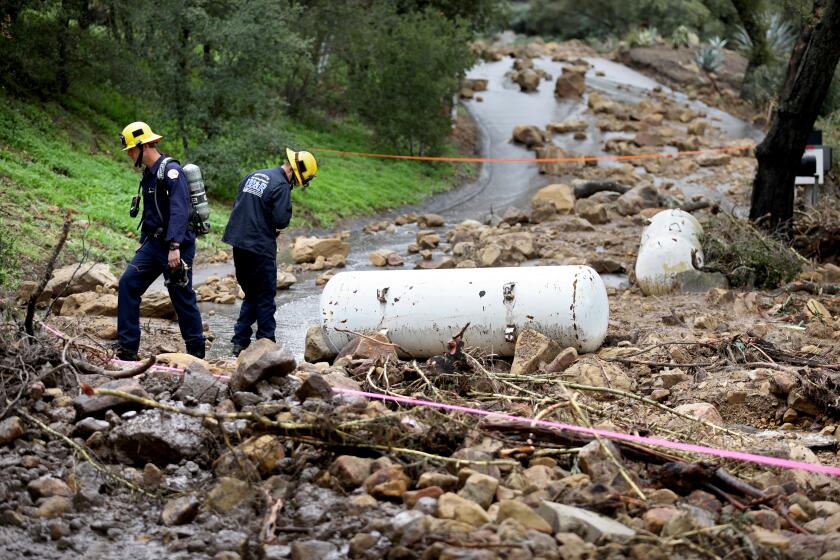Major atmospheric river storm is barreling toward California: ‘Prepare for the worst’

- Share via
A major atmospheric river storm — strong enough to potentially rival some of the extreme storms that have walloped Southern California in recent winters — is barreling toward the coast, raising the specter of damaging landslides and flooding across the region.
This storm, forecast to reach Southern California shortly before Valentine’s Day on Friday, is expected to be the strongest of the winter so far, according to the National Weather Service office in Oxnard.
It threatens to drop large amounts of rain — 2 to 4 inches or more along the coast and in valleys, 4 to 8 inches or more in the mountains and foothills — across a swath of the Southland. There’s a 60% chance of rainfall of that magnitude in Santa Barbara and San Luis Obispo counties, and a 40% chance in Los Angeles and Ventura counties — chances that have increased in recent days.
There’s also a small chance rainfall could be even more extreme for Santa Barbara and San Luis Obispo counties.
The time of greatest concern for potential landslides from recently burned areas is expected to be Thursday night, the weather service said.
Storms, fires and the positioning of Montecito have resulted in a precarious existence for the town’s mostly wealthy residents.
“Definitely, people should be prepared that this is going to be the wettest period that we’ve had so far this rain season — since the fires started,” said Ryan Kittell, a National Weather Service meteorologist in Oxnard.
“People should prepare for really the worst-case scenario,” Kittell said, where heavy rainfall could send mud and debris sliding off hillsides, mucking up roads and possibly colliding into homes and other structures.

Animated infographic shows a debris flow works
For Santa Barbara and San Luis Obispo counties, rain could start late Tuesday night and last through through the evening on Friday — Valentine’s Day, said Rose Schoenfeld, a weather service meteorologist. The biggest threat is expected to be on Thursday.
“Certainly, if you are in a vulnerable area around those burn scars, keep track of the weather each day and see how the projections trend and what seems to be the most likely outcome going forward,” Kittell said. “Prepare for the worst and hope for the best.”

Santa Barbara and San Luis Obispo counties could see 12 to 24 hours or more of rainfall, with precipitation coming down at rates from half an inch to an inch or more per hour. Rainfall rates of half an inch or more per hour are capable of causing significant debris flows, in which water can pick up mud, rocks, branches and sometimes massive boulders, traveling at speeds exceeding 35 mph.
A rainfall rate in that range “typically does lead to some flooding concerns, especially for the recent burn areas,” Kittell said. That includes the burn area of the 2024 Lake fire, which scorched 38,664 acres in the Santa Barbara County mountains north of Los Olivos.
As rainfall rates approach 1 inch per hour, flooding can be triggered anywhere, especially on roads and in small creeks, Kittell said.
Previously, the weather service warned there was a 20% chance of an extreme rainfall scenario occurring in Santa Barbara and San Luis Obispo counties that would drop 4 to 8 inches of rain on the coast and in the valleys. That risk is now lower than 20%, and has a “small chance” of occurring, Schoenfeld said.
There is now a 30% chance of intense rain between Feb. 12 and 15 in Los Angeles, Ventura, Santa Barbara and San Luis Obispo counties, the National Weather Service said.
This storm now looks like it will fall short of being as powerful as the historic Jan. 9, 2023, storm, one of the most powerful storms in recent memory for Southern California. That forced the mass evacuation of Montecito and other communities, caused significant flooding, and resulted in the deaths of two motorists — including a 5-year-old boy — who were caught in floodwaters in San Luis Obispo County.
The 2023 storm dumped 16 inches of rain on the Santa Ynez Mountains — the range that towers above Santa Barbara and Montecito. This week’s storm likely won’t produce as much rain. And another difference is the 2023 storm was one of a string of powerful systems that hammered California from late December 2022 through mid-January 2023. This season has been far drier — one of the driest starts to the rainy season in modern California history — “so the impacts will probably be less,” Kittell said.
For Los Angeles and Ventura counties, besides the 40% chance of large amounts of rain, there’s also a 60% chance of moderate amounts. Light rain could arrive starting early Wednesday, with the highest threat between Thursday morning and Friday morning, before lighter rain ends Friday night.
For all four counties, there is a 5% to 10% chance of thunderstorms Thursday and Friday, which could bring locally brief heavy rain, gusty winds and small hail.

A moderate event could cause some road flooding, but the risk of debris flows would be low, though still present, Kittell said.
Large amounts of rainfall would result in a “fairly high risk” of producing downpours so intense that all of the region’s recent burn areas are at risk for debris flow, Kittell said.
More refined forecasts on the amount of rain and how heavy it will fall are expected as the storm approaches. Should the cold front moving through the area “be on the stronger side with more southerly and stronger winds, rainfall will greatly enhance across the southern coastal slopes,” the weather service said.
Recently burned areas are at risk for landslides in heavy rain, as the soil is no longer anchored by healthy vegetation. Heat from fire makes it harder for soil to absorb water, and ash also tends to clog the soil, so water is more likely to flow along the surface rather than percolating down.
Under one likely scenario, the weather service said that between Tuesday night and Friday, downtown L.A., Long Beach, Redondo Beach and Northridge could get about 2 inches of rain; Santa Clarita and Oxnard, 2.3 inches; Westlake Village, 2.4 inches; Pomona, 2.45 inches; Fillmore, 2.72 inches; San Luis Obispo, 3.04 inches; Cambria, 3.24 inches; and Santa Barbara, 3.52 inches.

The storm is also expected to be strong in the San Joaquin Valley and Sierra foothills, potentially affecting travel along the mountain passes of Kern County, the weather service office in Hanford said.
The storm is expected to bring moderate effects to San Diego and Orange counties and the Inland Empire. Those areas are expected to see widespread rainfall Wednesday through Friday. There’s an 80% to 95% chance this region will see 1 or more inches of rain from the coasts through the mountains. The coasts and valleys also have a 40% to 60% chance of seeing more than 2 inches of rain.
Palm Springs has a nearly 50% chance of 1 or more inches of rain, “as the moisture will be deep enough to stretch into the deserts,” the weather service office in San Diego said.
The storm is expected to bring moderate to heavy rain and mountain snow to the Sacramento Valley. The Sierra Nevada could see 2 or more feet of snow, and areas around the elevation of Lake Tahoe could see “their largest snow event so far this season,” according to the weather service office in Reno.
After a relatively weak storm expected to arrive in L.A. late Thursday, forecasters say a potentially more powerful storm could hit around Valentine’s Day.
The San Francisco Bay Area and Santa Cruz and Monterey counties can expect urban and small stream flooding, as well as the possibility of shallow landslides and a slight risk of flash flooding, the weather service said. The Bay Area is expected to get its heaviest rain Thursday.
The upcoming storm follows heavier than expected rainfall from a system that left Southern California on Friday. For the two-day period that ended at 5 p.m. Friday, Santa Monica received 1.26 inches of rain; Beverly Hills, 1.46 inches; Porter Ranch, 1.53 inches; Alhambra, 1.64 inches; downtown L.A., 1.71 inches; East Pasadena, 2.07 inches; and Malibu Hills, 2.5 inches. The mountains in L.A. County saw as much as 3.32 inches of rain.
That, combined with the rainfall leading up to Valentine’s Day, may be enough for Southern California to end “high fire season” and transition to “low fire season,” Kittell said, where vegetation is wet enough that “the risk for any large fires will be fairly small for the rest of the winter into the spring.”
There will need to be conversations with a number of agencies, including firefighters, before making that determination, “but we’re certainly trending in that direction.”
California’s snowpack stands at 65% of average for this time of year. After a dry January, major storms are forecast to bring more rain and snow.
Downtown L.A. has received about 2 inches of rain since the water year began Oct. 1, almost all of it since late January. The typical average at this point — roughly halfway through the traditional rainy season — is 7.93 inches. The annual average is 14.25 inches.
Meteorologists have said that the region needs 2 to 4 inches of rain, widespread, for high fire season to end.
More to Read
Sign up for Essential California
The most important California stories and recommendations in your inbox every morning.
You may occasionally receive promotional content from the Los Angeles Times.
















